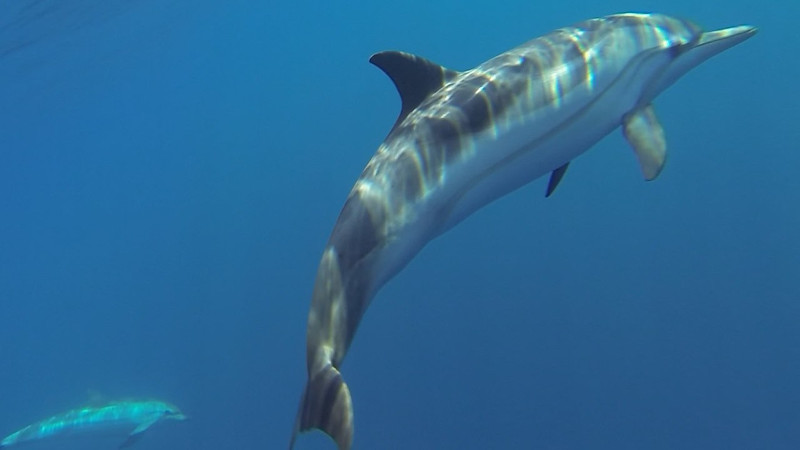
Striped Dolphin Facts
- This magnificent marine mammal most frequently goes by the descriptive common name of the Striped Dolphin for obvious reasons. Yet, it also has another, less often employed general title. That’s the somewhat clinical term of euphrosyne dolphin.
- Inside of the scientific community, though, it’s perhaps better known by its technical designtion. That, however, like so many such, is a difficult one for the layperson to pronounce. That’s because it holds the official moniker of Stenella coeruleoalba.
- The beautiful creature received that epithet due to the efforts of Franz Julius Ferdinand Meyen. The Prussian botanist and physician recorded the first recognition of it as a separate and distinct species. He managed that scientifically noteworthy deed in 1833.
- Thankfully, the remarkable Striped Dolphin appears to be maintaining a reasonably thriving base population. That pleasant state also seems to hold true throughout the entirety of its native range. The IUCN thus now lists the cetacean as Least Concern.
- The animal nevertheless faces numerous threats to its continued existence as a species. Like most forms of life on the planet, most of these stem from the actions of man. They include active hunting in parts of its range, plus the effects of climate change.
Related Articles
Striped Dolphin Physical Description
The amazing Striped Dolphin fully deserves the great deal of attention it receives from admirers of its appeal. Yet, the mammal does not do so due to its physical size. That’s true since, in that respect, at least, it’s an approximately average member of its Family.
In fact, in some ways the animal closely resembles several other related species with which it shares its territory. Notable examples of this include the Atlantic Spotted Dolphin and the Clymene Dolphin. They’re close in dimensions, but present different appearances.
It does, however, share many traits with its cousins. Among these is the fact that it demostrates a certain degree of the physiological characteristic of sexual dimorphism. In its specific case, though, this natural trait manifests itself solely in terms of length and weight.
More specifically, males attain a greater overall mean size than their female counterparts. This holds true for both body length and total mass, as well. That gender-based difference remains comparatively minor, however. They thus closely resemble each other at a distance.
The mature males reach a maximum known length equaling roughly 8.5 ft (2.6 m). Their typical weight measures about 352 lb (160 kg). Females, meanwhile, usually reach up 8 ft (2.4 m) in length. Body masses for them also stay slightly less, at around 330 lb (150 kg).
It’s in the coloring, though, where the Striped Dolphin sets itself apart from those many relatives. Its underside present various shades of either white, blue, or even pink. The eyes are encircled by one or two black bands. Thesse then extend across the back to the flipper.
Two more such stripes also run from behind the ear to the same point. The upperside of the body shows either gray or light blue. Strikingly, however, all its appendages present a deep black hue. The nose develops as short, yet elongated, like most of its many kindred.
- Kingdom: Animalia
- Phylum: Chordata
- Class: Mammalia
- Order: Artiodactyla
- Family: Delphinidae
- Genus: Stenella
- Species: S. coeruleoalba
Striped Dolphin Distribution, Habitat, and Ecology
The gorgeous Striped Dolphin evolved as native to a broad swathe of the marine regions of the globe. The full extent of that zone of habitation might surprise some people, though. That’s simply due to how many oceans and seas this biological wonder inhabits.
The creature lives in both the South and North Atlantic Oceans, for starters. Yet, it also dwells in most of both the Indian and Pacific Oceans. Within these regions, it’s frequently sighted in the waters of the Mediterranean Sea and the Gulf of Mexico, among others.
Inside of the greater range, the remarkable dolphin develop decidedly strong and clear preferences regarding its choice of habitat. It’s range itself makes one of these clear. Given that territory, the animal strongly prefers tropical to warmer temperate climates.
It further displays strong favoritism for areas far offshore, away from continental shelves. Some local populations, in different parts of the world, additionally possess slight migratroy patterns of behavior. Even in these cases, though, it continues to stay in deep water.
Like most of its many cousins, the spectacular Striped Dolphin evolved as a highly social animal. Most individuals therefore travel in large groups. Some of these assemblages, though, number the hundreds, and occasionally even in the thousands of these marvels.
It’s also purely carnivorous in its feeding habits. It preys on a fairly wide range of creatures, though. These include different species of squid, fish, octopus, krill, and other crustaceans. It has few natural predators itself, but those that do include Orcas and large sharks.
Species Sharing Its Range
Check out our other articles on 4 Stunning Bering Sea Species, Executioner Wasp, Southern Darwin’s Frog, Blood Falls, Great Rhododendron, Nicobar Pigeon, Mountain Apollo, Saltwater Crocodile
